Contact with Tang Dynasty China increased during the Nara Period (710-784). Paintings and sculpture during the period came to be modeled closely on the style of the contemporary T’ang dynasty.
The establishment of the capital city “Heijo-kyo” (平城京) in Nara (奈良) where the court had moved to, marked the beginning of the Nara Period. Based on the Tang model, Chang-an city, it was the first permanent capital of Japan from A.D. 710-784. The word “Nara” is thought to be derived from the Korean word meaning “country”.
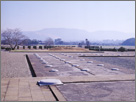
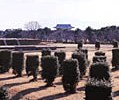 Ruins of Heijyo Palace
Ruins of Heijyo Palace
The Nara period is characterized by the maturing of the ritsuryo system of government, inspired by the Chinese model, as well as the adoption of many other aspects of Chinese culture and technology.
During the Nara period the power and influence of Buddhism grew under the supervision of Buddhist monks who had studied in and returned from Tang China. Temples in Japan accumulated vast landholdings during this era, their priests gained tremendous political influence (particularly during the reigns of Emperor Shomu and Empress Shotoku). Buddhism in Japan had the stamp of Tang control: ten Buddhist masters who had studied in Tang China as well as the superintendents placed in charge of temple property, extended state control over all Buddhist matters.
With the burgeoning numbers of worshippers and clergy, many temples had to be constructed. There were about two hundred temples at the beginning of the period but over a thousand at the end of it. Thus Buddhism gained official recognition as the state religion, and the network of Buddhist temples served to buttress the authority of the central state.
Emperor Shomu created a statewide system of temples with Todai-ji Temple at its centre by decreeing that nationally-sponsored temples were to be built in the outlying provinces. The idea had originated with his great-grandfather Temmu who had decreed that Buddhist chapels be built in outlying areas. But unlike the small chapels of Temmu’s era and beyond what was seen in the Tang Chinese temple system, Emperor Shomu went much further to actually initiate ambitious building projects of grand temple compounds complete with seven-storied pagodas in outlying regions as well.
Another key difference: Emperor Shomu’s ambitious religious works of temple building, suggested by his edict of 741, were motivated by the wish to bring to end the series of national disasters (drought and poor crops) and the smallpox epidemic that had broken out in 735 , and to restore health and prosperity to the land. His new provincial temples were actually named the Golden-Light, Four-Heavenly-Kings, Protect-the-State temples.
Emperor Shomu (r. 729-749) became known as a great patron of Buddhism at the time, commissioning many works. Buddhist deities in bronze, wood, clay and lacquer were commissioned to fill temples.
One such famous and enduring work is the colossal bronze Buddha (Daibutsu) of Todai-ji temple. It was constructed to secure the prosperity and protection of the entire nation.
With the official state sponsorship of the arts and the commissioning of so many religious and cultural works, the Nara period is known for the flowering of the arts known as Tempyo culture.
And on the surface, it would appear that Nara enjoyed great prosperity, with Tempyo Buddhist arts thriving and peaking during the era. Ironically, the many palace and grandiose temple constructions such as Todaiji temple in Nara exhausted the state treasury. Later chroniclers accuse Emperor Shomu of having depleted the country’s reserves of bronze and precious metals through his massive undertaking of the casting of the bronze Daibutsu Buddha.
Those were times of uncertainty and instability — Nara society was stricken by rebellions, epidemics, droughts and storms. Life was hard for both aristocrats and commoners. With the hectic capital relocations, aristocrats were overworked with heavy administrative burdens and management difficulties. Arable land was often in shortage and records showed the yields of the field were not sufficient to meet the basic needs of the household. Excavations showed that dwelling sizes of commoners had actually shrunk as compared with previous eras. Common people found corvee labour and taxes too onerous that many abandoned their land and turned vagrant. The Nihon shoki reported poor crops in one area of Japan or another for almost every year of the period.
The bankruptcy of the court’s coffers notwithstanding, Heijokyo’s many surviving great monuments and cultural legacies — Buddhist temples, Shinto shrines and the excavated remains of the great Imperial Palace — provide a vivid picture of what life must have been like in the Japanese capital in the 8th century.
For more on the cultural influences of Tang China on the Tempyo culture of the Nara Period, see Nara court and ceremony and the flowering of Tempyo culture
___
[Note: Although Nara was the permanent capital, it was not the only one. After the rebellion of Fujiwara no Hirotsugu in 740, Emperor Shomu moved the capital three times. In 744, the court was moved briefly to Naniwa-kyō which then became the new capital, before returning to Heijō-kyō, when the construction of the Great Buddha resumed.]

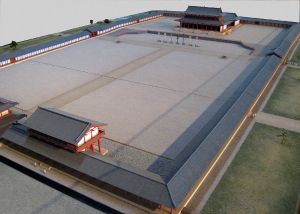
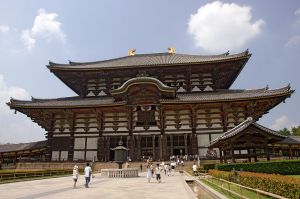

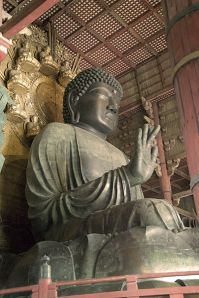
Thanks for putting up the excellent site.
I found the following lines are a bit questionable:
>The word “Nara” is thought to be derived from the Korean word meaning “country”.
To my knowledge, it is Koreans, perhaps only Koreans, who think (or believe) that the Japanese place name “Nara” is derived from the Korean word meaning “country.” Let me make a brief argument on this point:
When the ancient Korean immigrants first settled in Japan, they certainly named their new settlements after their places of origin, such as Korai (高麗) and Niiza (新座; 新羅 in older name), to name a few. But I don’t think there is the slightest possibility that they named any of their settlements “Nara.”
As you know, when the first European immigrants settled in America, they named many of their new settlements after their places of origin. But did they ever name any of their settlements “Country”? No, never. The word “country” is a common noun and naming some particular place “Country” would be ridiculous. And this would also be true with the common Korean noun “nara” for the same reason.
A quick search shows that the Korean word “nara” first appears in the record from the medieval period. It is unknown what word was actually used to signify “country” in the earlier period contemporary to the Nara Period.
The Nara City web site tells that “Nara” is derived from its terrain, with flat land profiles and gentle slopes.
Another site says that the name is derived from Mount Nara (那羅山), which was named when the government army trod down on the grasses while they were setting up a camp on the mountain (though I doubt this is a true story). Today Mount Nara is known to be the site of the graveyard for some ancient imperial family members.
All in all, it seems that the Koreans’ claim – that “Nara” is derived from the Korean word meaning “country” – is mostly turned down by the local government and history-savvy Japanese bloggers and citizens, as well as historians.
Thank you, and hope to keep up the good site.
Good points made. I have been looking into this too. There may be other possible origins for “Nara” as well. I will make the changes when I have delved deeper, thanks.
i would also like to point out, isnt Todaiji temple was built to rival the Sui and Tang dynasty temple?. The Daming Palace temple is quite impressive as it was built on elevated platform of 50 meter or something. because lack of imagery of what tang dynasty temple used to look like, would be nice to see if it resembles that of japan
It’s really hard to tell what the original buildings in China (and Korea) looked like, unlike Japanese buildings that are extant for around than 1,500 years. The Daming temple structures date back to the Qing Dynasty (1644-1911)…and the Jianzhen memorial hall from 1977. Oftentimes, the replicated buildings are based on the Japanese oldest ones, and that circular visual image we are given, is a problem that has been noted in both replica architecture as well as archaeological papers.
mostly they were based on painting and oldest japanese architecture.
https://www.quora.com/How-much-was-Japan-influenced-by-the-Tang-dynasty
even from the painting we can see many similarities if not some are identical